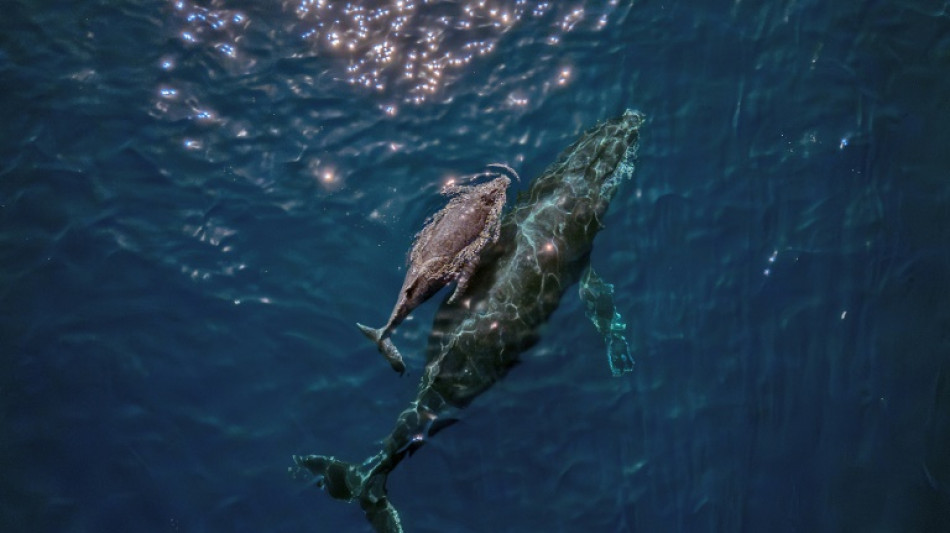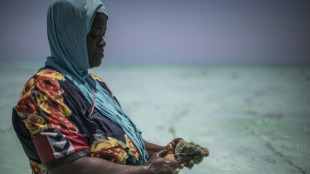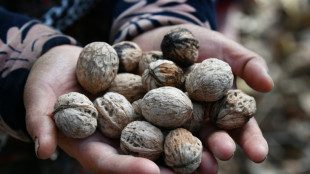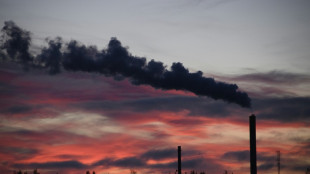
-
 Hitler likely had genetic condition limiting sexual development: research
Hitler likely had genetic condition limiting sexual development: research
-
Zelensky sanctions associate as corruption scandal engulfs Kyiv

-
 Germany agrees to keep military service voluntary
Germany agrees to keep military service voluntary
-
Japan PM Takaichi says she sleeps only 2-4 hours a night

-
 South Africa announces plan to bid for Olympic Games
South Africa announces plan to bid for Olympic Games
-
Juan Ponce Enrile, architect of Philippines martial law, dies at 101

-
 Stocks waver as US government shutdown ends
Stocks waver as US government shutdown ends
-
Google to pay millions to South African news outlets: watchdog

-
 EU probes Google over news site rankings despite Trump threats
EU probes Google over news site rankings despite Trump threats
-
Pakistan grants lifetime immunity to president, current army chief

-
 South Africa's Bavuma says winning in India top ambition
South Africa's Bavuma says winning in India top ambition
-
Alldritt back to captain France against Fiji after South Africa loss

-
 Juan Ponce Enrile, architect of Philippine martial law, dies at 101: daughter
Juan Ponce Enrile, architect of Philippine martial law, dies at 101: daughter
-
'Ready' Rees-Zammit back in Wales's starting team to face Japan

-
 Spinners decide Tests in India, Gill says before South Africa opener
Spinners decide Tests in India, Gill says before South Africa opener
-
K-pop group NewJeans ends feud with record label ADOR

-
 Asian stocks rise with focus on Fed, tech as US government reopens
Asian stocks rise with focus on Fed, tech as US government reopens
-
UK economic gloom deepens before budget

-
 Scott Barrett returns to skipper All Blacks against England
Scott Barrett returns to skipper All Blacks against England
-
Burberry narrows first half loss on turnaround plan

-
 Sri Lanka to stay in Pakistan after bomb, games move to Rawalpindi
Sri Lanka to stay in Pakistan after bomb, games move to Rawalpindi
-
Zanzibar women turn to sponge farming as oceans heat up

-
 Stocks rise with focus on Fed, tech as US government reopens
Stocks rise with focus on Fed, tech as US government reopens
-
Curry lifts Warriors over Spurs, Thunder rout Lakers, Jokic shines

-
 Mushroom material takes on plastic packaging at Belgian start-up
Mushroom material takes on plastic packaging at Belgian start-up
-
India's top tennis player says denied China visa

-
 In Kyrgyzstan, world's largest natural walnut forest thins away
In Kyrgyzstan, world's largest natural walnut forest thins away
-
TV soaps and diplomacy as Bangladesh and Turkey grow closer

-
 Striking Boeing defense workers to vote on latest contract
Striking Boeing defense workers to vote on latest contract
-
Australia's opposition ditches commitment to net zero emissions

-
 Duffy takes four as New Zealand crush West Indies to seal T20 series
Duffy takes four as New Zealand crush West Indies to seal T20 series
-
South Korea halts flights for college entry exam

-
 Trump signs bill to end record-breaking US shutdown
Trump signs bill to end record-breaking US shutdown
-
EU lawmakers to vote on unpicking green business rules

-
 Smith says England speed kings could struggle in Ashes
Smith says England speed kings could struggle in Ashes
-
Stocks stutter with focus on Fed, tech after US reopen vote

-
 Record-breaking US shutdown ends as political fallout begins
Record-breaking US shutdown ends as political fallout begins
-
France marks decade since harrowing Paris attacks

-
 Skubal, Skenes win MLB Cy Young Awards for top pitchers
Skubal, Skenes win MLB Cy Young Awards for top pitchers
-
Record rains turn Argentina's farm-filled Pampas plains to wetlands

-
 Solar storm brings new chance of vivid auroras, signal disruptions
Solar storm brings new chance of vivid auroras, signal disruptions
-
Gauff and Fritz back for United Cup against Swiatek's Poland

-
 World's fossil fuel emissions to hit new record in 2025: study
World's fossil fuel emissions to hit new record in 2025: study
-
SRH Total Return Fund, Inc. Increases its Quarterly Distribution by 21.2% - Fifth Consecutive Annual Increase

-
 Classover Reports Record Third Quarter Results, Delivering Profitability and Accelerating AI Tutor and Digital Asset Strategy
Classover Reports Record Third Quarter Results, Delivering Profitability and Accelerating AI Tutor and Digital Asset Strategy
-
Banyan Gold Intersects 3.66 g/t over 17.6 m Continuing to Extend High-Grade Mineralization in Airstrip Deposit, AurMac Project, Yukon, Canada

-
 Pivotree Announces Third Quarter 2025 Results
Pivotree Announces Third Quarter 2025 Results
-
National Energy Services Reunited Corp. Reports Third Quarter 2025 Financial Results

-
 Algorithmic Insurance Services Inc., dba American Takaful Insurance Solutions Appointed to Develop Takaful America, the First Large-Scale Takaful Insurance MGU in the United States
Algorithmic Insurance Services Inc., dba American Takaful Insurance Solutions Appointed to Develop Takaful America, the First Large-Scale Takaful Insurance MGU in the United States
-
Skymantics Offers Full-Spectrum AI Services for State and Local Government, From Strategy to Secure Automation


Back from the brink: the migratory species on the road to recovery
While a landmark new report on the world's threatened migratory species is a catalogue of decline and destruction, the handful of animals staging a comeback shows improvement is possible -- if humans change their ways.
From the majestic humpback whale launching into the air from the waves, or the thousands of snub-nosed saiga antelope fanning across the steppes of Central Asia. These sights would have been barely possible without the concerted conservation efforts that have helped these species rebuild populations.
The State of the World's Migratory Species assessment, published Monday, found that animals, fish, birds and reptiles listed for protection under the UN Convention on the Conservation of Migratory Species of Wild Animals (CMS) were seeing declines across the world.
Around 70 of the threatened species saw their conservation status worsen between 1988 and 2020.
But 14 have shown an improvement, it found. Here are some of those recovering species:
- Humpback whales -
For hundreds of years, whalers from across the planet hunted humpback whales for their oil, meat, and baleen -- their feeding filtration system.
According to the International Union for Conservation of Nature (IUCN) they were targeted by early hunters in their wintering areas near the West Indies and Cape Verde, then near their summer feeding grounds from the 1860s, especially off Iceland and Norway. In the Pacific they were hunted particularly by Japanese whalers.
By 1986, the IUCN had listed the species as globally endangered.
International restrictions on commercial whaling allowed the humpback whale population to rebound and today, more than 80,000 mature individuals navigate throughout the world's oceans.
While some subpopulations have now recovered more than 90 percent of their pre-whaling numbers, the CMS report said other smaller groupings like the humpbacks in the Arabian Sea, were still endangered.
Continuing threats include from fishing gear, underwater noise pollution, and collisions with ships.
- Vicuna -
Vicunas, a llama-like creature that roams wild in parts of Argentina, Bolivia, Ecuador, Chile, Peru, is one of the few undomesticated animals sought for its wool.
Illegal poaching brought vicunas to the brink of extinction.
Numbers are now increasing thanks to legal protection from hunting, an international trade ban and education initiatives and the vicuna conservation status has changed from near threatened to least concern.
But threats from poaching for the illegal market, habitat encroachment and climate change remain.
- Lesser Kestrel -
The lessekestrel was once one of the most abundant small, migratory birds of prey that could befound from Spain to southern Russia to China.
The use of pesticides, especially DDT from the 1940s to 1970s, poisoned the birds directly and caused a drastic reduction in prey.
Habitat loss from urbanisation and agricultural intensification also caused severe population declines throughout Europe.
Since the 1980s, targeted conservation efforts -- like providing artificial nests, restoring breeding colonies, and releasing captive-bred birds into the wild -- have helped boost populations in southwestern Europe.
- Saiga Antelope -
National and international conservation efforts helped bring the Saiga Antelope back from the brink of extinction.
The revival of Kazakhstan's steppe and wetland habitats, projects to reintroduce native species and efforts to work with local communities to address overexploitation all played a role in their recovery.
Its population in Kazakhstan rebounded from a perilous low of 50,000 individuals in 2006, to over 1.3 million in 2022.
The species has now partially resumed migration into Uzbekistan.
- Black-Faced Spoonbill -
The black-faced spoonbill is a migratory seabird found in North and South Korea, China, Russia, Japan, Vietnam, Cambodia, Thailand, and the Philippines.
These white wading birds travel along a restricted migration route for breeding and wintering.
Their habitat has come under threat from growing human populations and agricultural and industrial development, while the birds face pesticide pollution, hunting, and the collection of eggs from nesting sites.
But legal protections, the designation of breeding sites as seabird sanctuaries and wetland restoration projects have all helped to improve the species' status from critically endangered to endangered.
O.M.Souza--AMWN

